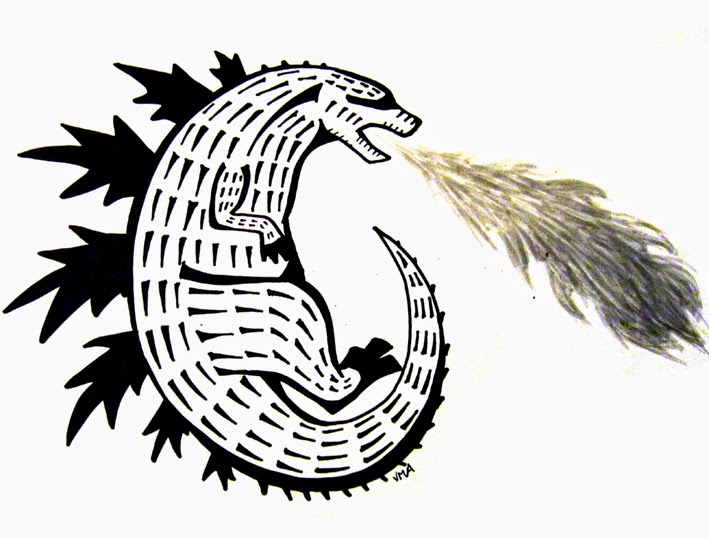The first offering of Paleo201, Dinosaurs in the Fossil Record, essentially comes to an end today with the final field trip of the semester. The students will have their exam later in December.
Even though it is a lot of work to be involved in the creation of a new course, I think Paleo201 is a great addition to the University of Alberta's paleontology offerings. Using the Dino101 content on Coursera, and pitched at an essentially first-year level (despite its 200 designation) for students from all faculties, Paleo201 is what's called a blended learning course. We rely on the Dino101 course videos to deliver the base lecture content for the course, which means we typically only meet once per week for an in-class lesson. These lessons have included research talks by grad students in our labs on topics relevant to each week's lesson. However, we also tried to break away from the lecture format for at least some of the in class lessons, to take advantage of some of the resources available on campus. One week we learned the basics of the rock cycle and general Canadian geology using the Department of Earth and Atmospheric Sciences Geoscience Garden, an installation of rocks from around Canada arranged in a particular fashion for students to learn basic mapping skills. And last week we did tours of the Paleontology Museum and our prep labs, including sneak peeks of some cool up and coming research projects. FUN FACT: Our Dunkleosteus skull cast was ranked higher than the dinosaur specimens in my highly scientific 'what did you find most interesting' poll. Blindingly obvious take-home message for instructors: Students like new things and surprises, and dinosaurs are not necessarily the be-all and end-all!
But the highlights, in my opinion, are the three field trips to Jurassic Forest, Dry Island Buffalo Jump Provincial Park, and the Royal Tyrrell Museum.
Jurassic Forest is a tourist attraction outside of Edmonton that features animatronic dinosaurs set outside in a forest. Although I had some comments that this was an odd place to take students on a university field trip, I actually think it worked really well as a way to ease students into some of the topics covered in the first couple of lessons – basic dinosaur anatomy, diversity, diet, etc. And because a lot of the signage and interpretive material at the forest has been put together by graduates of the UofA's BSc program in Paleontology, the educational content is accurate, up to date, and nicely presented.
Many of the students told me that our trip to Dry Island was the first time they had really gone hiking, so I think that speaks to the value of having a course like this one. We hiked the students around the badlands and out to the Albertosaurus bonebed, stopping to discuss geology, look for fossils (but not collect any, as we didn't have permits this time), and talk about how we interpret bonebeds and make inferences about dinosaur behaviour. Everyone was SO EXCITED to find little bits and fragments of bones. A couple of the students told me they returned the next weekend with their families because they had enjoyed the field trip so much! Blindingly obvious take-home message for instructors: Students like to go outside! And while videos and online stuff and lectures are perfectly fine, doing 'real' things with real fossils and real locations etc. etc. can never fully replace the online experience. Also I got artists and history students and linguistics majors and such to like rocks, so there.
And today we headed down to the Tyrrell Museum, which is a bit of a long day trip from Edmonton, since Drumheller is a little more than 3 hours away – but we were helped along by some dino documentaries. As always, the museum is an amazing resource, and it was super fun to see the students putting together many of the different concepts learned this semester. There were many good questions and enthusiastic discussions about the things we were seeing. And of course, having Phil there to talk to the students about the history of the museum and some of his personal experiences in collecting many of the fossils on display is pretty cool!
Because this is partly an online course, one of the things I've tried to incorporate into the field trips is discussion of the field trip in the course discussion forums. Each time the students have had to take a picture of themselves with a backdrop of choice (favourite dinosaur at Jurassic Forest, favourite scenic view at Dry Island, favourite display at the Tyrrell) and tell us something about it. This worked really well and it is also a fun way to get some feedback about what people are twigging onto as interesting in the course. Fun fact: Not everyone's favourite dinosaur/etc. was T. rex! There is hope for the world!
This is the last course for which I will ever be a teaching assistant, as my grad school days are wrapping up in a few weeks. This course was lots of fun to teach, hopefully has been fun to take, and I hope future students and instructors have as much fun as I did!


































